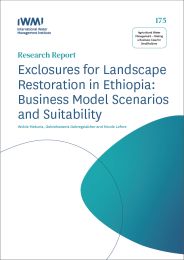IWMI Research Report – 175
Citation:
Mekuria, W.; Gebregziabher, G.; Lefore, N. 2020. Exclosures for landscape restoration in Ethiopia: business model scenarios and suitability. Agricultural Water Management – Making a Business Case for Smallholders. Colombo, Sri Lanka: International Water Management Institute (IWMI). 62p. (IWMI Research Report 175). [https://doi.org/10.5337/2020.201]
Abstract
Land degradation is a critical problem around the world. Intensive rain-fed and irrigated crop and livestock systems have contributed to the degradation of land and natural resources. Numerous institutional and socioeconomic challenges complicate attempts to reverse land degradation, including the lack of short-term incentives for investment; low investment by communities in natural resources management that offers little immediate financial reward; failure of public sector institutions to invest sufficiently in natural resources management because of low, immediate political rewards; and sectoral fragmentation, among others. In poor communities, the incentive to extract short-term economic returns from land and natural resources often outweighs perceived benefits from investing in long-term environmental restoration, and related economic and ecosystem returns.
Restoring degraded ecosystems through the establishment of exclosures – areas that are excluded from woodcutting, grazing and agricultural activities – is an increasingly common practice in the Ethiopian Highlands, and regional states are also following this practice. This report proposes and applies an adapted business model to explore the feasibility of exclosures for land restoration. It aims to identify short-term revenue streams from activities that can be carried out within exclosures, such as beekeeping, harvesting fodder for livestock fattening, and cultivating high-value plant species, including fruits and herbs. These are feasible, sustainable economic activities that could allow for the restoration of ecosystem services over the long term. Mobilization of financial resources, engagement of local communities, provision of training and continuous follow-up, as well as facilitation of market opportunities in the value chain for local communities and enterprises (e.g., creating market linkages and establishing innovation platform to engage with market actors) could support the sustainable implementation of the revenue streams.
ISSN 1026-0862
ISBN 978-92-9090-896-8


